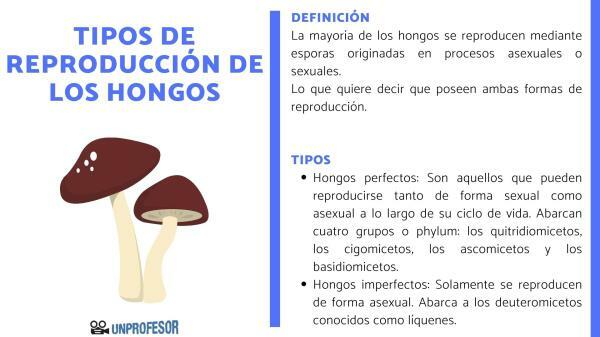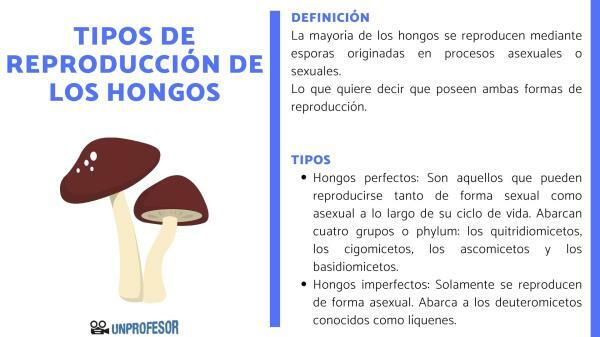Types of REPRODUCTION of fungi

Fungi belong to fungi kingdom, and, unlike plants, they are heterotrophs so they do not produce their own food, their way of feeding is saprophytic, since they absorb or ingest decomposing organic matter. They are present in all environments, mainly in moist substrates. your way of reproduction allows these organisms to disperse over large areas. They make up one of the oldest groups of eukaryotes, but their past history is poorly understood.
Did you know that within this kingdom we find more than 71,000 species? Within them we can find unicellular specimens such as the well-known yeasts that we use in the manufacture of bread and beer, and multicellular organisms such as the famous mushrooms, hat mushrooms or mushrooms
If you want to know more about the types of fungal reproduction, We invite you to continue reading this article by a Teacher.
Index
- What are the types of reproduction of fungi
- Asexual reproduction
- sexual reproduction in fungi
What are the types of reproduction of fungi.
If you want to know how fungi reproduce you have to take into account what we call reproduction to formation of new individuals possessing all the characteristics of the species. Most fungi reproduce by means of spores originating from asexual or sexual processes.
Which means that they have both forms of reproduction. Thanks to this we can detect these types of fungal reproduction:
- perfect mushrooms: They are those that can reproduce both sexually and asexually throughout their life cycle. They encompass four groups or phylum: the chytridiomycetes, the zygomycetes, the ascomycetes, and the basidiomycetes.
- Imperfect mushrooms: They only reproduce asexually. It includes the deuteromycetes known as lichens.
Perhaps you are wondering what spores are, then we will tell you what these particular structures are about.
what are spores
We can compare the spores with tiny seeds of microscopic size. The spores are surrounded by a hard and resistant wall, which is why they have the ability to remain dormant, they are able to resist periods of drought or extreme temperatures and germinate only when the environmental conditions are favorable. They have the advantage of being so small that, with the help of the winds, water currents and driven by insects or animals, they can disperse in large areas, although not all reach germinate.
Asexual reproduction.
Within the types of reproduction of fungi, we have to differentiate the asexual reproduction of sexual. Fungi have various mechanisms of asexual reproduction, it can also be known as vegetative reproduction. One of the advantages of this type of reproduction is that the fungi can colonize substrates more quickly and efficiently.
exist various types of asexual reproduction in fungi:
- sporulation: They reproduce by means of spores. As we mentioned before, it is the most common method of asexual reproduction. These spores are produced by mitosis and released into the environment. Some can produce only one type of spores, others up to 4 different types throughout their life cycle.
- Gemmation: A new individual is formed from a small outgrowth or bud of the parent organism.
- Fission: It consists of the bipartition or mitosis of a mother cell to give rise to two identical daughter cells. It occurs in unicellular fungi such as yeasts.
- soma fragmentation: Each fragment of the body transforms into a new individual.
sexual reproduction in fungi.
We end this lesson on the types of fungal reproduction by talking about the sexual one. How is sexual reproduction in fungi? Some fungi have sexual organs called gametangia, these are female and male gamete makers. The female gamete-forming organs are called oogonia and the male antheridia.
sexual reproduction takes place through the union of these gametes, It happens in a similar way to the process that occurs in plants and animals. When the nuclei of these two haploid cells unite, a zygote or egg is generated and this is followed by the creation of the sac or conidium that will produce the sexual spores, these can remain inactive for long periods of time, only when the conditions of the environment are adequate, they recover their viability, thus being able to germinate, giving rise to new hyphae (filaments that form a new fungus).
inside this varied group we can find:
- holocarpic: They are hermaphrodite organisms, they have both types of organs (female and male) in the same thallus and, if they are compatible, they can reproduce by self-fertilization.
- Eucarpics: They retain a thallus with male or female organs. In order to mate, they need to communicate with another specimen that has organs of the opposite sex, they do this through pheromones and chemical substances that they release into the environment. Crossing over depends on the compatibility of factors that determine the closeness of a compatible hypha. It is known as plasmogamy to the invasion of a cell to the cytoplasm of another, subsequently, the fusion of both nuclei (karyogamy), a zygote is generated that will form a sporangium containing haploid sex cells or meiospores.
Since asexual reproduction requires less energy expenditure and can occur under unfavorable environmental conditions, you may ask... What is the advantage of sexual reproduction over asexual?
Contrary to what happens with asexual reproduction, in sexual reproduction they gather characteristics or traits of two parents, which means that both male and female cells contribute their genetic material to form a zygote. As a result, a daughter cell different from the parent cells is obtained, this increases the genetic diversity of the species.

If you want to read more articles similar to Types of fungal reproduction, we recommend that you enter our category of biology.
Bibliography
Curtis, h. (2004). Biology (6a. ed. 5a. reimp.). Buenos Aires: Pan American Medical.


